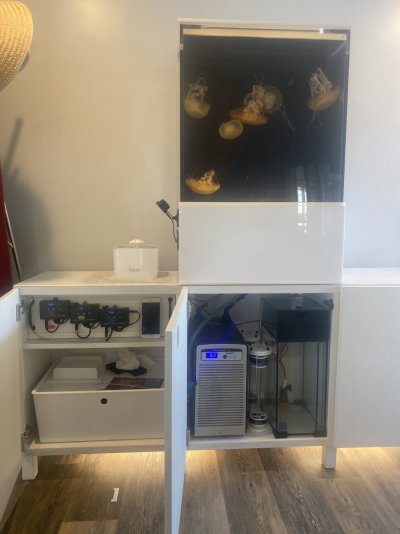- Joined
- Sep 22, 2015
- Messages
- 169
- Reaction score
- 85
A year ago during Covid I adopted six pacific Sea Nettles from local aquariums that had to close. I have had many moon jellyfish in the past for approximately 10 years. The tank is custom-made from a friend of mine in Southern California called pacific marine labs specializing in moon jellyfish The tank is almost a year old and during the time of cycling I cycled the tank at 78° with seated bio balls,The tanks filtration system is a simple three stage filter system with a 10 gallon reservoir at the bottom for pumps and various equipment(sump)
It is directly under the tank it is shallow there’s not a lot of room for any tall Equipment etc. skimmers reactors.
1.Mechanical filters (Filter floss)
2.Carbon filter ( chemipure blue)
3 Bio ball chamber
No skimmer
The Cycle took a l while but once cycled I reduce the temp to 61° They actually prefer colder but 61 is pretty much the limit. I introduced 2 medium size jellyfish at a time and since dropping the temperature have struggled with Ammonia , Nitrate , Nitrates and phosphates.
The really cool thing is there’s absolutely no algae to show that the nutrients are high because such a low temp.
I want to Install 2 external media reactors 1.To boost up Biological filter was some kind of extreme porous rock like Seachem matrix 2.some kind of phosphate and nitrate Reducer. I don’t feel the amount of bio balls and not having any live rock in there is doing any justice I have put four small bio blocks in the sump area. I have not Noticed anything from those there’s not a lot of water movement in that reservoir. They’ve been in there for about four months.
Here’s the question
Is it because I’m running such a low temperature I’m having such a hard time with the bio filtration and will this still be problem if using other bio filtration media?
PS. As of now I’m doing a lot of water changes but is highly not recommended because jellyfish don’t breathe the water, they are the water
Thank
JELLY MAN


It is directly under the tank it is shallow there’s not a lot of room for any tall Equipment etc. skimmers reactors.
1.Mechanical filters (Filter floss)
2.Carbon filter ( chemipure blue)
3 Bio ball chamber
No skimmer
The Cycle took a l while but once cycled I reduce the temp to 61° They actually prefer colder but 61 is pretty much the limit. I introduced 2 medium size jellyfish at a time and since dropping the temperature have struggled with Ammonia , Nitrate , Nitrates and phosphates.
The really cool thing is there’s absolutely no algae to show that the nutrients are high because such a low temp.
I want to Install 2 external media reactors 1.To boost up Biological filter was some kind of extreme porous rock like Seachem matrix 2.some kind of phosphate and nitrate Reducer. I don’t feel the amount of bio balls and not having any live rock in there is doing any justice I have put four small bio blocks in the sump area. I have not Noticed anything from those there’s not a lot of water movement in that reservoir. They’ve been in there for about four months.
Here’s the question
Is it because I’m running such a low temperature I’m having such a hard time with the bio filtration and will this still be problem if using other bio filtration media?
PS. As of now I’m doing a lot of water changes but is highly not recommended because jellyfish don’t breathe the water, they are the water
Thank
JELLY MAN
Last edited:



















